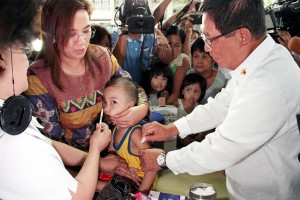The exodus of people from typhoon-ravaged areas, the limited access to health services in poor areas and the reluctance of some parents to have their children vaccinated are being cited by the Department of Health (DOH) as having set off the surge in measles cases in Metro Manila.
Health Secretary Enrique Ona said that the migration could be a contributing factor to the outbreak.
“The numbers started to rise in September last year,” Ona said.
So far, three measles-related deaths have been reported in Metro Manila—one each in Caloocan, Malabon, Muntinlupa.
The DOH said that last year’s measles cases jumped to 417 from the 45 reported in 2012.
Most of the patients came from the cities of Las Piñas, Malabon, Muntinlupa, Quezon, Pasay, Taguig, Manila, Caloocan, Parañaque, Makati and Valenzuela. Only the cities of Muntinlupa and Malabon had one confirmed deaths each.
Health Undersecretary Janet Garin said the spike in measles cases was also triggered by the earthquake in Bohol in October and the onslaught of Typhoon Yolanda in Visayas in November, which exposed affected residents to the disease.
Garin said some parents refused to let their children be given anti-measles vaccine shots at health centers.
She noted that areas where measles cases were reported were the same places where dengue and Chikungunya outbreaks were reported.
To control the measles outbreak, the DOH plans to vaccinate all children in outbreak areas. The agency is targeting a 95 percent immunization coverage not only in Metro Manila but in all cities, municipalities and provinces.
In a meeting Monday, health officials in Metro Manila admitted that some areas in the country were only up to 85-percent immunized, and there areas with a “very alarming” 45-percent rate.
Only 6 percent of the available measles vaccine was administered to children last year.
The Philippines aims to be measles-free by 2017, which means that for every one million Filipinos, there should only be one laboratory-confirmed case.
Health officials said the law requires two doses of measles vaccines for children once they reach nine months and 12 to 15 months.


